Pattern as Cosmology in Islamic Geometric Art: 1
Introduction
The subject of this section of my Special Topic is kashikari, or simply kashi, in early Persian tile work. I am dependent for my understanding of the subject on (1) Douglas Pickett’s massive study of its historical backgrounds, development and proliferation and (2) Mr. Hassan, my Pakistani tutor’s, analysis of Pickett’s twenty pages of line drawings, which reproduce, by retracing, many kashi designs. Kashi is an art half geometrical, half vegetal in form. Before I turn to discuss this amalgam and to recapitulate Pickett’s and Hassan’s analyses of various examples, I thought that I would return for more introduction to the geometric art of Islam, including the stricter forms that I will take up in much greater detail in Section 4 of this presentation.
For those who do not have time for Eric Broug’s, Islamic Geometric Patterns, or Keith Critchlow’s larger Islamic Patterns: An Analytical and Cosmological Approach, David Sutton’s 58-page Islamic Design, A Genius for Geometry may suffice. Critchlow was Sutton’s teacher. Says Sutton: “The art of pure ornament revolves around two poles: geometric pattern, the harmonic and symmetrical subdivision of the plane giving rise to intricately interwoven designs that speak of infinity and the omnipresent center; and idealized plant forms or arabesques, spiraling tendrils, leaves, buds and flowers embodying organic life and rhythm. This book focuses on Islamic geometric patterns, exploring their structure and meaning.”
From Sutton’s “Closing Thoughts”: “Traditional Islamic ornament is eminently functional — but its function is not utilitarian. It seeks to compensate for the spiritual losses of civilization by re-establishing something of the primordial beauty of virgin nature and to transport the viewer from immersion in the mundane to serene contemplation. Islamic design can be thought of as a form of visual music; the repetition and rhythm of its motifs establish an inner sense of balance and act as a visual extension of the invocatory remembrance of the Divine,” which may be found within. Sutton here describes the severe art of the compass and straight edge, but his remarks are not irrelevant to the freer inspiration of organic kashi designs.
“The simplicity and apparent inevitability with which many Islamic geometric patterns unfold belie the effort involved in finding them. The anonymous artisans concerned most surely have regarded them as pre-existent possibilities gifted from the Source to those who proved worthy. Not a few such craftsmen must have been well aware of the abjad equality between the words “point,” nuqta, and “geometer,” muhandis, and aspired to allow this transcendent relationship to shine through in their works.” Both the strictly geometric and the looser kashi forms, which combine the vegetal with the geometric, are my subjects in parts 1 and 4.
Pattern as Cosmological in Islamic Geometric Art: 1A
Today Hassan and I opened a new subject, or rather a massive work of scholarship about it: Douglas Pickett's Early Persian Tilework: The Medieval Flowering of Kashi (London: Associated University Presses, 1997), the last of a dozen books that I ordered.
On pp. 76-96 Pickett includes line drawings that retrace and reproduce a variety of important decorative kashi motifs. Together Hassan and I looked at twelve of these 20 pages, and he illuminated various features of their design.” Kashi art,” he said, “is under the influence of nature.” In this of course it differs from the severe geometric art that we had been considering in Keith Critchlow’s, Eric Broug’s and David Sutton’s books. “Among its motifs are the endless knot, well known from the arts of weaving and knotting.”
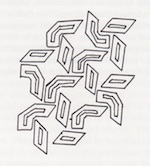
Hassan pointed out many reflective elements, as in the figure at the upper left on p. 76, composed of boomerangs and parallelograms. “Kashi art,” he noted, “models itself on utilitarian objects, as well as foliage and other organic elements.” We looked at many designs that are organic, many that are more strictly geometric. “Reflective art,” said Hassan, “is typical of an early stage of development,” and in this Early Persian Art we can see the roots of later Persian art.” On p. 80 we studied examples of symmetrical Kashi patterns.
Elements from nature are reduced to thin abstraction. Thus symmetry and natural imagery are represented with simplicity, as geometrical forms in an abstraction of things. On p. 81 we looked at a figure that alternates vertical with horizontal forms, they both suggesting two-dimensional reductions of three-dimensional geometric forms. We studied deceptively simple but actually complex triangular sequences, whose interstices of parallelograms are equally important. On pp. 82-83 we studied arboreal, highly floreate forms.
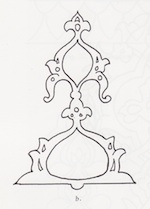
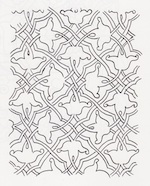
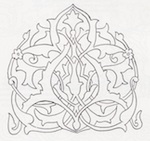
On pp. 84-85 (above) we looked at trees that include Islamic architectural domes, an arabesque that incorporates a motif of weaving, a “complete rambler based on a simpler form from the tympanum of a mosque’s mihrab.” A complex geometrical form within overlaps a natural motif. Hassan concluded by noting that “These designs are so perfect that they may be adapted to many household and domestic uses: clothing, a bedspread, the design for a wall, but they are conceived here as the models for developing decorative tile work.”
Herewith more reflections on the Arabesque by Pickett and Hassan, plus more generalizations about geometric Islamic art:
Arabesque: the gardens of paradise (pp. 14-15 in Sutton, Islamic Design: A Genius for Geometry [New York: Walker, 2007]). Hassan began by remarking: “Every Arabic culture has a different idea as to what is appropriate and effective in foliate design.” “Arabic arabesques,” he said, with reference to the illustration in the upper right-hand corner of p. 15, “sometimes have domes, or images similar to calligraphic patterns.” Hassan called foliate design “a feminine art,” as he pointed silently to the curvature of certain forms.
He noted the greater freedom that the artist of arabesque exercises over the freedom of the creator of geometric patterns. Hassan compared this freedom to that of the innovative calligrapher. So foliate designs are “different from severe geometrical abstraction and different too from one another; each arabesque is unique.” Arabesque, he reminded us, often serves as a background for a single calligraphic redaction of the Qur’an. “Such forms,” said Hassan, “represent an art of nature rather than an art of mind.”
Four-fold Permutations: quadruples in quadrangles (pp. 22-24) “Reflection,” Hassan observed, “is the key to these works.” Sutton remarks: “Joining the centers of squares set in a regular tiling defines another square tiling — the square grid is its own dual.” “These designs,” said Hassan, “are often used for the reflection of light or the reflection off water.” “They represent,” he added, “a variety of shapes with the same theme; they have an obvious symmetry.” Sutton: “Often two triangles, long edge to long edge, form a square.”
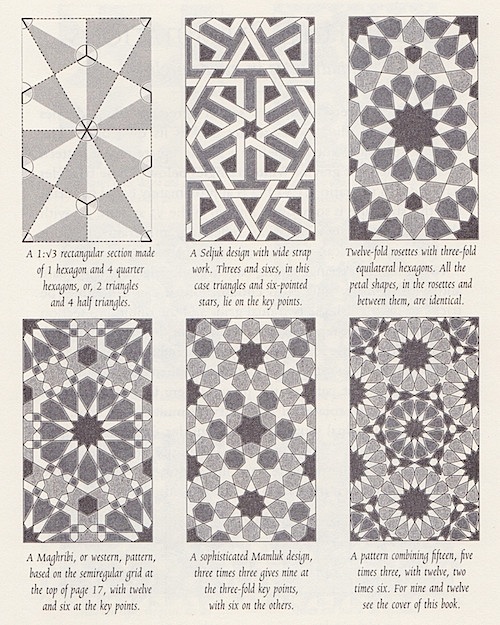
Self-Similarity: the same at different scales (pp. 30-31). Hassan referred to the principle of “right-side up and upside down,” explaining the concept of self-similarity as “the shadow of an object and the object itself,” pointing to a bicycle parked before the restaurant in the morning sun and the shadow that it cast on the asphalt. “Self-similarity,” he said, “combines with symmetry. All abstract Islamic art is symmetrical,” he added. “Only art in which two figures are reflections of one another constitute an art that is self-similar.”
“The repetition of a color [in a pattern] is also a self-similarity,” he said. “Self-similarity is, moreover, a mathematical concept,” he added. “These are geometrical concepts, for example, that are self-similar.” He referred to “the vice-versa form of geometric calculation.” Next he raised the question of feeling in this abstract art. “The arabesque describes one’s inner feelings,” he argued. “Things that we cannot express ourselves. Such feelings,” Hassan continued, “cannot be described by mathematics, only by art.”
He ended with a bon mot: “Landscape painting expresses feelings that landscape does not.”
Pattern as Cosmology in Islamic Geometric Art: 1B
At the outset of his Chapter 3, “The Early Mongol Period: Background to the Corpus,” Pickett includes a general genealogy of the kashi designs that shows them to have arrived in Iran ultimately from China and from India. The former passed first through Central Asia, the latter
through Afghanistan. From Iran they diverged into Anatolia and Khurasan.
Pickett offers us extensive historical commentary, political, economic and sociological. He surveys history, he says, as a way of presenting (1) how buildings were treated (many were destroyed during invasions and rebuilt, occasioning the use of kashi, (2) how craftsmen were treated, and (3) how refugees were displaced by such violent events.
We can see that the treatment of buildings would have varied from place to place. Maragha was ruined, we know, yet three of its pre-Mongol tomb towers have survived, whereas Hulegu’s observatory has not, having been ruined when Mustawfi wrote in 1340. Tus was so ruined that only fifty houses were left standing.
More observations: “The Mongols’ treatment of craftsmen was on the whole much better than that of the civil population, in cases where they had resolved on a general massacre. . . . Which,” Pickett says, “brings us to the question of refugees. . . . The story of the conquests shows that populations did not, on the whole, flee their cities as is often suggested.”
These names of supposedly Persian craftsmen appear among those of many Anatolians and Syrians who presumably had something more positive than a Mongol invasion to make them work in Anatolia. It would seem to me that whatever Persian craftsmen did work in Anatolia went there because of Seljuk patronage.
Another important point: “There was nothing specifically Islamic, at least at this early period, about kashi itself. Kashi was used for Christian, Buddhist and Jewish buildings. . . . It will probably be fruitless, therefore, to seek some specifically Muslim interpretation of kashi composition, though at first sight such a search might seem to be attractive.”
Extant kashi work is rather sparse. In Chapter 5, “The revival of Kashi, 1300-1325,” says Pickett, “After a period of eighty years, during which there is very little Kashi in Iran . . . we come to the first quarter of the fourteenth century, when suddenly there are sixteen surviving building complexes or family groups that bear witness to the use of mosaic Kashi.”
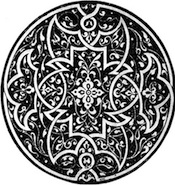
Pickett in description of the Arabesques in general (and in particular): “The central scheme of all the arabesques consists of a stem splitting into tendrils, which swell outward, then re-converge to enclose a lemon-shaped field (turunj). The point of convergence is marked by a flower or disk that becomes a stem for many subsequent bifurcations.”
Some Arabesques take the form of the Tree of Life. “An essential requirement is that it grow symmetrically from bottom to top. Another form is the arabesque diaper (net, or reticulation), which grows not in a single direction but extends over the surface equally in several directions. . . . For asymmetrical panels there are asymmetrical arabesques.”
Pattern as Cosmology in Islamic Geometric Art: 1C
Amidst our study of re-sketched kashi designs taken from the rather sparse extant examples of early Persian tile work, I asked Hassan whether he regarded this work as sacred or secular. I thought that the reader might find his response of interest:
“Rather than strictly sacred,” he said, “these works. along with the abstract art of the Indonesian Ikat and batik textiles that we have been looking at, are beautiful, an expression of the beauty of God, of his symmetry, of his reflectivity, of his self-similarity.
“All these qualities, which we have found in the severe Islamic geometric patterns, in the kashi designs for tile work, in the Indonesian designs for textiles to celebrate life rhythms, may be regarded as aspects of the regularity and order of God’s beauty.”
“God has made the world beautiful for man’s pleasure and edification,” Hassan continued. “In the tree there is wood for furniture, there is fruit for food; but its leaves turning in the wind are also beautiful. The tree grows slowly, as does a beautiful baby.”
He extended this to a more general observation: “Since humans cannot see God, they must create patterns that express him, beautiful things that express his beauty. Humans want beauty in their daily lives. Kashi represents the worlds of nature and domesticity.”
“In kashi the actual tree designs are not so much representations of arboreal forms as vertical concatenations of repeated design elements,” Hassan remarked. “Rather than naturalistic forms that mirror nature, they instead constitute symbols of growth.”
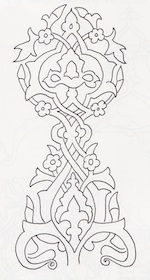
“Their geometrical parts are linked as chains and guilloches. In the desert a tree would be found in a garden, an oasis. It must be cultivated; therefore it is both a natural and an artificial form. Under the sun, the tree would be a place to rest from the day’s heat.”
Pattern as Cosmology in Islamic Geometric Art: 1D
Hassan, a Muslim believer, a mathematics and physics major, a geometer, and a very astute analyst of the patterns to be found in kashi (which, like Islamic geometrical art, breaks with tradition and so is unlike the marginal Islamic tradition of Indonesian textiles, which absorbs and builds upon native traditions) continued his commentary today on individual kashi design as expressed and reembodied in modern sketches:
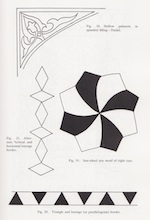
Figure 19 in Pickett's book (p. 81) represents “A sun-wheel star motif of eight rays. It is based,” he continued, “upon a square, which includes the white rays, beyond which the black rays extend, four of each.” Hassan remarked that color would significantly alter the effect of the black-and-white design that we had looked at. “This powerful figure, he noted, is really two overlapping squares, one (the black) larger than the other (the white).”
Figure 21 in Pickett (p. 81 again) shows a tower of elements composed of alternating vertical and horizontal lozenges. I had earlier recorded Hassan’s observation that the lozenges here read as the sides of three-dimensional geometric figures (all cubes seen in perspective). Today he noted that they are separated from one another by 90-degree angles. “So the pattern reveals 90-degree symmetry,” said Hassan. “in each of its individual figures.”
Figure 20 in Picket (p. 21). The preceding design, like many others that we looked at today, was designed as a decorative border. Figure 20 represents triangles disposed horizontally and separated by parallelograms. Hassan remarked that “this is a perfect way to join these two geometrical shapes.” He pointed to another border design for comparison, Figure 18, which shows (says Pickett) “a hollow palmette in a spandrel filling — Dashiti.”
Pattern as Cosmology in Islamic Geometric Art: 1E
P. 86, example c., from the Blue Mosque, Tabriz, is “a common rambler composition for small surfaces, relatively simple.” Hassan tells me that it would have been intended for the inside of a dome, where the need to bend the design and conform to the curvature explains its simplicity. One openwork pattern here overlaps another made of two tangent circles:
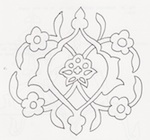
P. 86, example d. “These lines,” of a corner decoration for the Friday Mosque in Isfahan, Pickett notes, “are thickened and thus represent a late variety of compound arabesque that first appeared in the Blue Mosque, Tabriz.” “The design,” Hassan observes, “has an arboreal (or concatenated) abstract structure (with domes inside it), a trunk, branches and leaves.”
P. 88 Two tall designs, e. and f., are both from Bukhara. The first is a tree in which two patterns alternately overlap one another, incorporating abstract flowers. The second imitates knitting technique, in which an interwoven line is alternately drawn above and beneath another line. Hassan points out how artificial are the head-to-head and tail-to-tail motifs.
P. 89 shows two designs, for the floors of mosques. Hassan: “The first uses ‘square technique’ to produce a ‘reflective’ design. The second includes overlapping figures, a square with a floral center. There are four five-petaled flowers behind the design. The tree shape underneath enables it to be expanded to cover a larger area. The central star has eight points.”
P. 90 By contrast with the two preceding, open-ended designs, here we have two self-contained, isolated designs. “Rosettes,” says Hassan, “are typical of fourteenth-century work.” Figure c. uses at its center a twelve-pointed star made of overlapping arms, in which is the name “Ali,” which is a reference to the relative of Muhammad who succeeded him.
P. 91 shows a calligraphic design whose meaning is “The honor of the whole universe is God.” Accordingly, we might call it cosmological. Figure 31 is “an eight-cornered design in ‘square technique.’” The external portions of another design may be elaborated by creating a central lozenge and two lozenges at either end. The result is a module for extended borders:
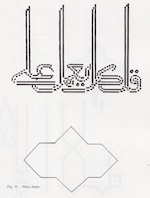
P. 92 Pickett calls this “a triple pentagon in Y form.” It is part of a fifteen-sided form with a “windmill” at its center. Figure 33 offers another example of aesthetic Arabic calligraphy abstracted into a striking design profoundly evocative for the Muslim reader. The text reads “Ya Allah,” where “Allah” means God and “ya,” to call,” Hassan explained.
P. 93 shows “Chinoiserie flowers.” Thus are other exotic elements incorporated into kashi.
Pattern as Cosmology in Islamic Geometric Art: Appendix
Glazed architectural decoration has been known in the Middle East from the earliest historical times. Turquoise alkaline glazes first appeared in Mesopotamia during the fifth millennium BC. Egypt and the Indus valley knew the technique of making glaze in the fourth millennium BC. The need to give architecture a colored revetment of some sort is just as ancient, as can be seen from the geometrical cone mosaic decoration on surfaces of the E-Anna temple at Uruk ca. 3500 BC. These cones were colored but not glazed. About the same period, however, the Egyptians were using tiles of siliceous sandy composition with a surface glaze stained turquoise with copper. Inlaid glazes of several colors have been found in the palaces of Ramses II and Ramses III in Egypt (ca. 1290-1150 BC), and at Knossos glazed tables have been found illustrating Minoan houses (ca. 1700 BC). However, the glaze that seems to have predominated throughout the early period was turquoise or a close variation of it, ranging from a deep malachite green to a very light blue. The spreading use of glaze may have been the result of substituting a cheaper medium for real turquoise stones, lapis lazuli, mother of pearl, pink limestone, and other natural color elements such as were often set in bitumen in early Mesopotamia. Turquoise has preserved its popularity right through to the present day. One form of it can be seen in the common folk pottery of modern Isfahan and the other in the talismanic beads sold to pilgrims at Qumm and Meshed. It was used as much for small objects and vessels as for architectural decoration. It was the preferred color used on the Elamite ziggurat at Choga Zanbil ca. 1250 BC, which had square tiles and raised central pommels glazed with copper oxide on an alkaline base, originally turquoise, but now degenerated. Glazed bricks, along with glazed orthostats and wall knobs, were used at Ashur from the twelfth to the sixth century BC, by which time the great schemes of figurative glazed decoration found at the Median site of Ziwiye but the climax of glazed architectural decoration in this early period is undoubtedly represented by the hieratic “Lion” and “Archer” figurative friezes executed for Darius in his palace at Susa. Alkaline glaze redominated down to about 600 BC, when lead became the most common flux for brick facades, requiring the surface to be covered first with a quartz frit.
(Pickett’s opening paragraph, summarizing the traditional, pre-Islamic Persian use of glazed architectural decoration)



